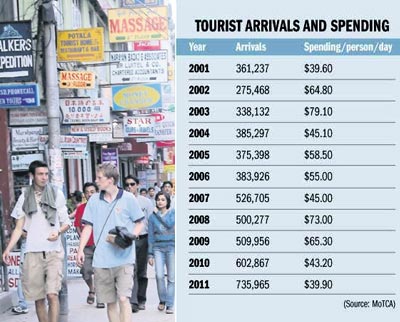

Tourism revenue falls due to day-trippers: Tourist Arrivals and Spending data

Nepal Tourism Year (NTY) may have brought a record number of tourists in 2011, but their average per day spending has dropped to a 10-year low.
Arrivals reached an all-time high of 735,965 in 2011, up 22.1 percent compared to 2010. But average spending by tourists has dropped to US$ 39.90 last year against US$ 43.20 of 2010, according to a preliminary study of the Ministry of Tourism and Civil Aviation (MoTCA). The average spending in 2011 has been calculated at the exchange rate of Rs 78 per US$ 1.
Government officials said that the reason behind the fall in tourist spending despite a growth in numbers was yet to be ascertained. However, they said that three major factors could be possible reasons—an increase in same-day visitors particularly pilgrims from the Southeast Asian market, a drop in quality tourists and their length of stay.
According to the MoTCA, tourist spending in 2011 was the lowest since 2001. In 2001, the average spending from each tourist stood at US$ 39.60 per day. A total of 361,237 foreigners visited Nepal in 2001. MoTCA chief statistician Rabi Prasad Kayastha said that pilgrim visitors occupying a large share of tourists in Nepal in recent years could be the major reason behind the low visitor spending.
Although pilgrims are considered to be big spenders in other countries, lack of tour packages by Nepali agencies has forced them to buy travel packages offered by Indian agencies. Travel trade entrepreneurs said that over 90 percent of pilgrim packages were being managed by Indian travel agencies.
Visitors from Sri Lankan, Thailand, and even India, a major source market for Nepal, are the top visitors for pilgrimage. According to the MoTCA, Sri Lankan visitors occupied the third position among total visitor arrivals in 2011. Arrivals from Sri Lanka amounted to 69,753 in 2011, of which only 1,926 had travelled Nepal by air. Similarly, visitors from Thailand amounted to 33,000 of which 6,431 were air travellers. Travel trade entrepreneurs said that a majority of the pilgrims came on Indian packages and were day-trippers.
Nepal Tourism Board spokesperson Aditya Baral said that a number of factors had contributed to the low tourist spending in Nepal. Fierce competition among Nepali agencies, more involvement of Nepali and foreign agents in dealing with same packages and the country’s inability to upgrade service have been hurting revenue, he said.
Similarly, according to Baral, a rise in pilgrimage travel has led to low spending as pilgrims have a short length of stay and spend less money. “In the past, the adventure travel segment used to attract the majority of visitors, but pilgrimage tours have surged in popularity nowadays,” Baral said.
Tourism entrepreneur Yogendra Shakya said that the NTY was specially focused on increasing visitors from the Southeast Asia, giving them priority over travellers from the long-haul markets like the US and Europe. But US and European travellers usually stay longer and hence spend more compared to their Asian counterparts.
“The fact is evident when we see the hotel tariff. As hoteliers have separate tariffs for the Southeast Asians, and the US and European clients,” Shakya said, adding that although there had been significant rise in the arrival of Asian travellers, hotel tariff for the Asians is relatively low.
Similarly, average length of stay of the Asian tourists is also lower compared to visitors from the US and Europe.
While hotel room rates have gone up by 50 percent in the last three years, they are still in recovery position. “Despite the drop in tourist spending in 2011, travellers’ demand in Nepal will command the price in the near future.”
TOURIST ARRIVALS AND SPENDING
Year Arrivals Spending/person/day
2001 361,237 $39.60
2002 275,468 $64.80
2003 338,132 $79.10
2004 385,297 $45.10
2005 375,398 $58.50
2006 383,926 $55.00
2007 526,705 $45.00
2008 500,277 $73.00
2009 509,956 $65.30
2010 602,867 $43.20
2011 735,965 $39.90
(Source: MoTCA)
News souce:The Kathmandu Post, 3 April 2012








